Menu Development, Planning, and Design Report for Pasco Cafe, LO1-LO3
VerifiedAdded on 2023/01/13
|12
|2727
|30
Report
AI Summary
This report provides a comprehensive analysis of menu development, planning, and design for Pasco Cafe. It begins with an introduction to menu types and then examines the principles of menu planning and design, considering factors like customer preferences, location, and equipment. The report delves into various customer and business requirements essential for maximizing profitability, including adapting to customer trends and addressing business needs such as staffing and legal regulations. Key factors in costing and pricing menus are explored, including direct and indirect costs, volatile market costs, and competitor pricing. The report then outlines the process of producing accurately costed and priced menus to meet a range of customer requirements, including sales mix, food cost percentages, and revenue sources. A realistic plan to develop a menu that meets customer and business requirements is presented, considering target customers, menu types, cultural preferences, and seasonal produce. The report concludes with an evaluation of the menu's success and areas for improvement, including menu engineering strategies and customer feedback, with the aim of maximizing the profitability of Pasco Cafe.
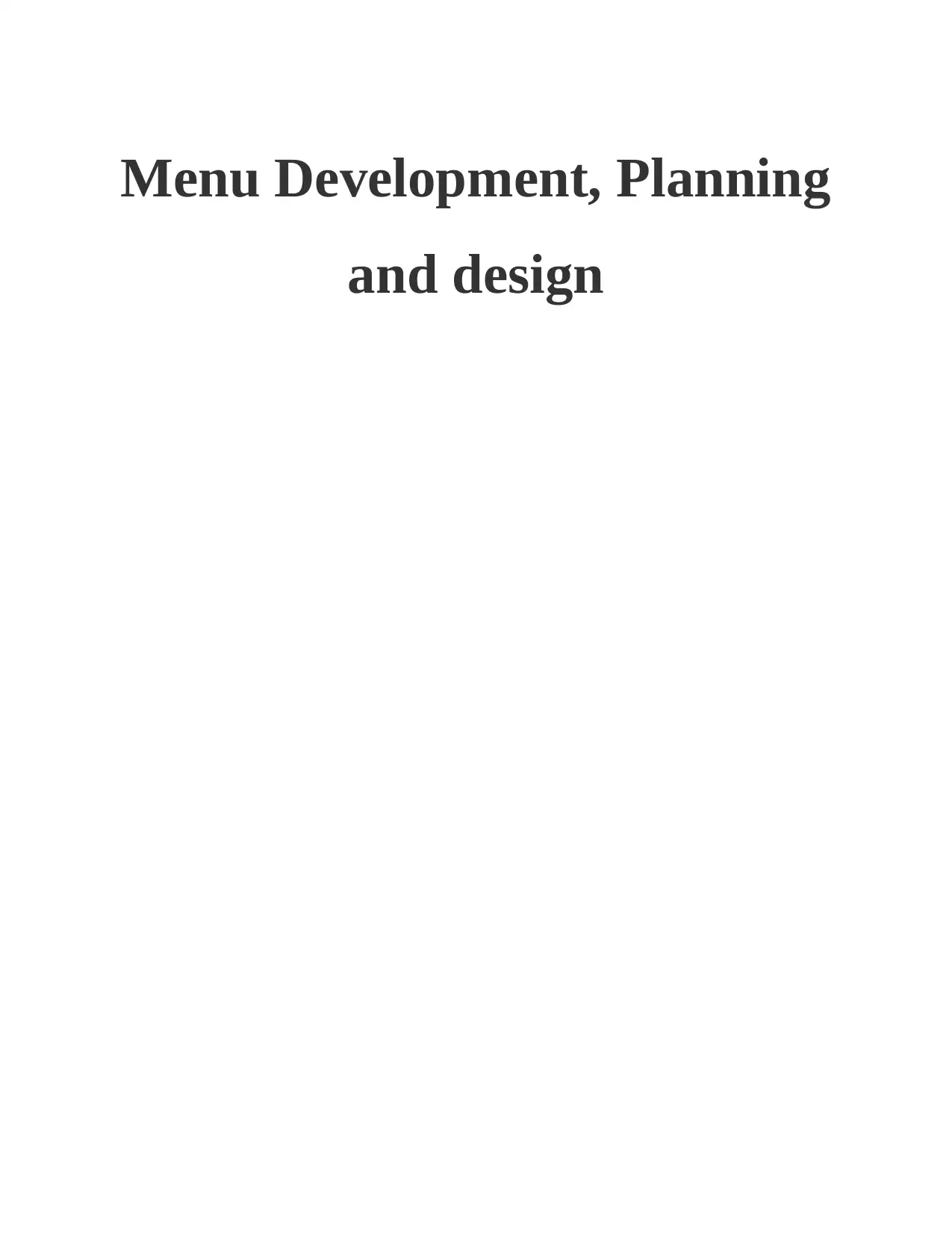
Menu Development, Planning
and design
and design
Paraphrase This Document
Need a fresh take? Get an instant paraphrase of this document with our AI Paraphraser
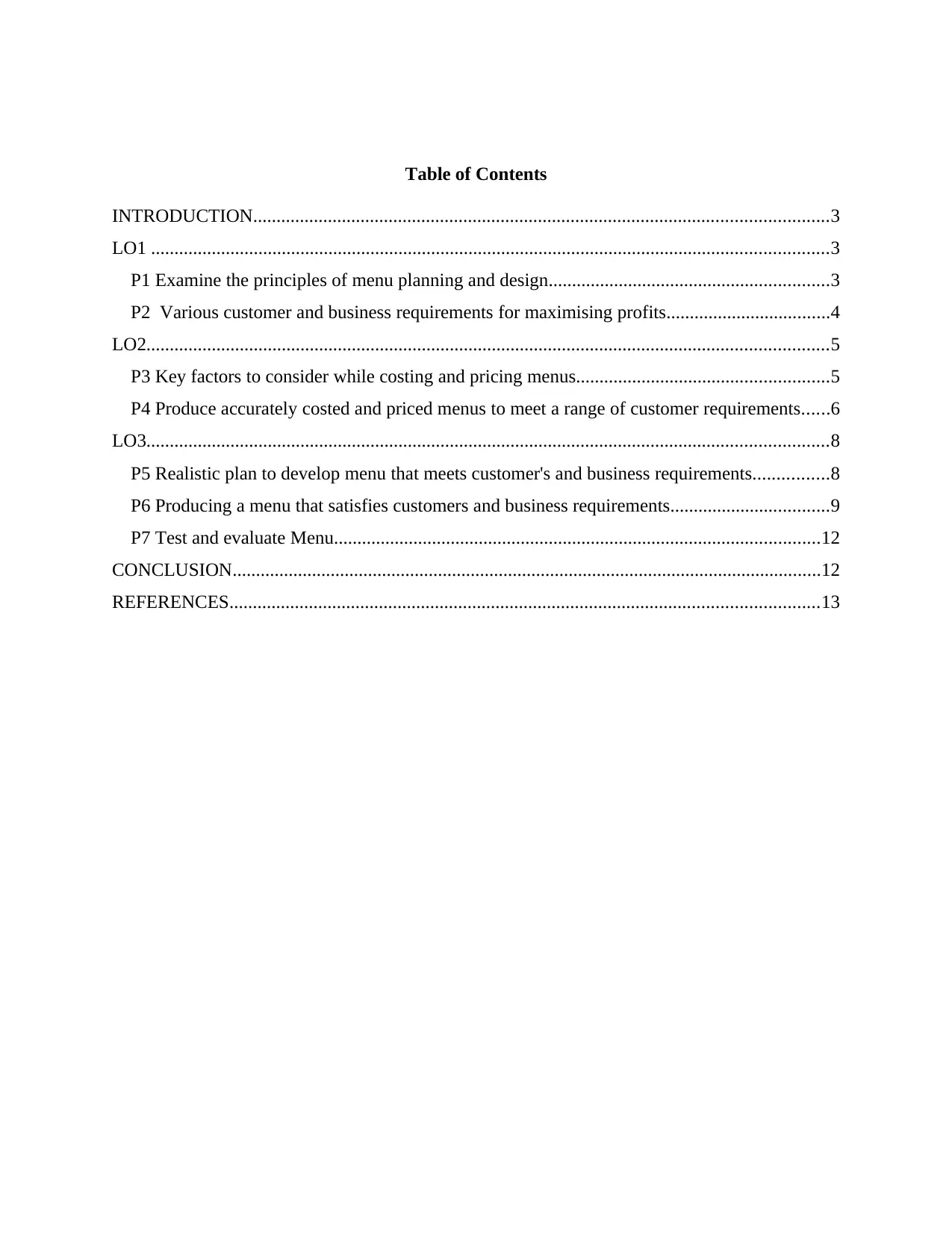
Table of Contents
INTRODUCTION...........................................................................................................................3
LO1 .................................................................................................................................................3
P1 Examine the principles of menu planning and design............................................................3
P2 Various customer and business requirements for maximising profits...................................4
LO2..................................................................................................................................................5
P3 Key factors to consider while costing and pricing menus......................................................5
P4 Produce accurately costed and priced menus to meet a range of customer requirements......6
LO3..................................................................................................................................................8
P5 Realistic plan to develop menu that meets customer's and business requirements................8
P6 Producing a menu that satisfies customers and business requirements..................................9
P7 Test and evaluate Menu........................................................................................................12
CONCLUSION..............................................................................................................................12
REFERENCES..............................................................................................................................13
INTRODUCTION...........................................................................................................................3
LO1 .................................................................................................................................................3
P1 Examine the principles of menu planning and design............................................................3
P2 Various customer and business requirements for maximising profits...................................4
LO2..................................................................................................................................................5
P3 Key factors to consider while costing and pricing menus......................................................5
P4 Produce accurately costed and priced menus to meet a range of customer requirements......6
LO3..................................................................................................................................................8
P5 Realistic plan to develop menu that meets customer's and business requirements................8
P6 Producing a menu that satisfies customers and business requirements..................................9
P7 Test and evaluate Menu........................................................................................................12
CONCLUSION..............................................................................................................................12
REFERENCES..............................................................................................................................13
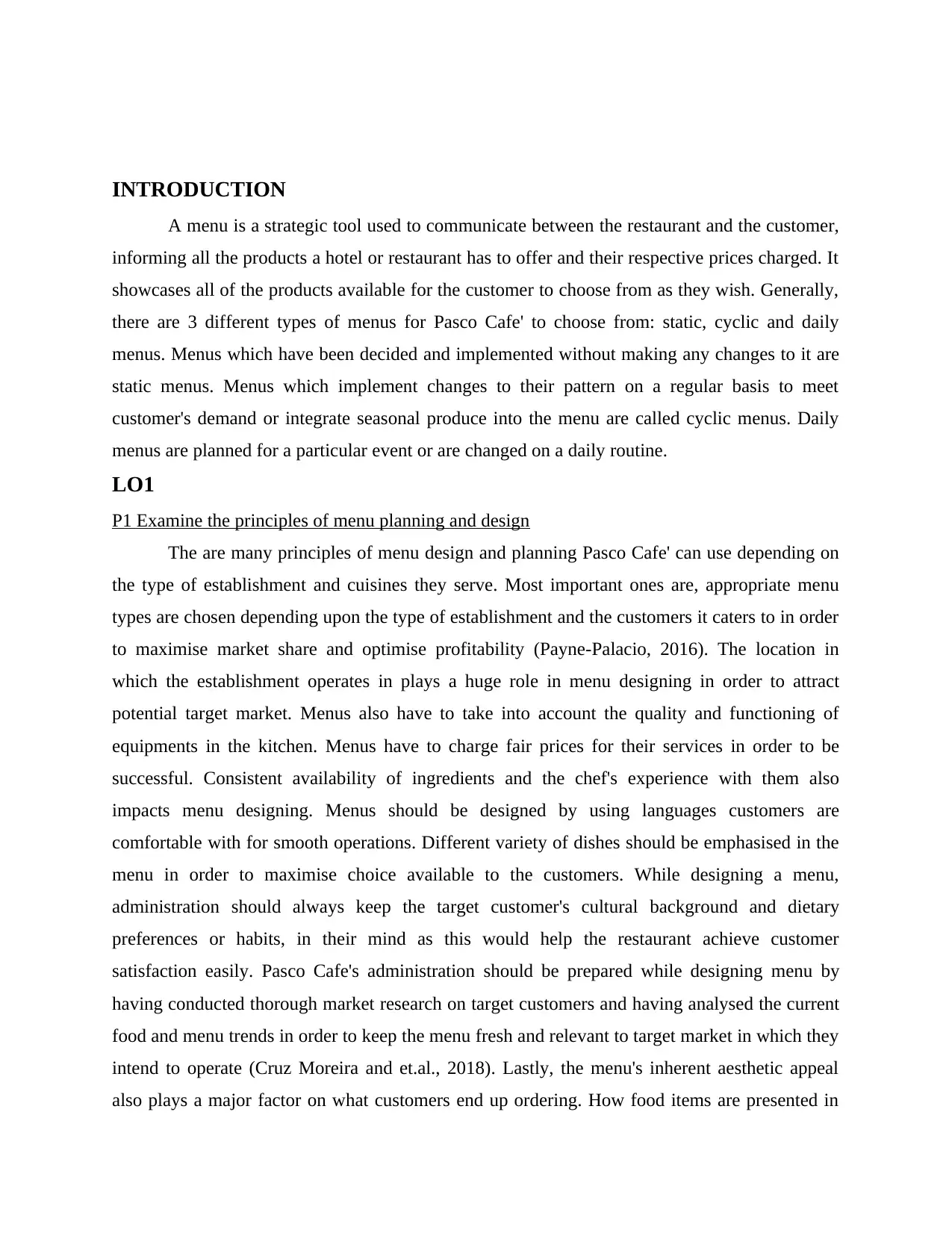
INTRODUCTION
A menu is a strategic tool used to communicate between the restaurant and the customer,
informing all the products a hotel or restaurant has to offer and their respective prices charged. It
showcases all of the products available for the customer to choose from as they wish. Generally,
there are 3 different types of menus for Pasco Cafe' to choose from: static, cyclic and daily
menus. Menus which have been decided and implemented without making any changes to it are
static menus. Menus which implement changes to their pattern on a regular basis to meet
customer's demand or integrate seasonal produce into the menu are called cyclic menus. Daily
menus are planned for a particular event or are changed on a daily routine.
LO1
P1 Examine the principles of menu planning and design
The are many principles of menu design and planning Pasco Cafe' can use depending on
the type of establishment and cuisines they serve. Most important ones are, appropriate menu
types are chosen depending upon the type of establishment and the customers it caters to in order
to maximise market share and optimise profitability (Payne-Palacio, 2016). The location in
which the establishment operates in plays a huge role in menu designing in order to attract
potential target market. Menus also have to take into account the quality and functioning of
equipments in the kitchen. Menus have to charge fair prices for their services in order to be
successful. Consistent availability of ingredients and the chef's experience with them also
impacts menu designing. Menus should be designed by using languages customers are
comfortable with for smooth operations. Different variety of dishes should be emphasised in the
menu in order to maximise choice available to the customers. While designing a menu,
administration should always keep the target customer's cultural background and dietary
preferences or habits, in their mind as this would help the restaurant achieve customer
satisfaction easily. Pasco Cafe's administration should be prepared while designing menu by
having conducted thorough market research on target customers and having analysed the current
food and menu trends in order to keep the menu fresh and relevant to target market in which they
intend to operate (Cruz Moreira and et.al., 2018). Lastly, the menu's inherent aesthetic appeal
also plays a major factor on what customers end up ordering. How food items are presented in
A menu is a strategic tool used to communicate between the restaurant and the customer,
informing all the products a hotel or restaurant has to offer and their respective prices charged. It
showcases all of the products available for the customer to choose from as they wish. Generally,
there are 3 different types of menus for Pasco Cafe' to choose from: static, cyclic and daily
menus. Menus which have been decided and implemented without making any changes to it are
static menus. Menus which implement changes to their pattern on a regular basis to meet
customer's demand or integrate seasonal produce into the menu are called cyclic menus. Daily
menus are planned for a particular event or are changed on a daily routine.
LO1
P1 Examine the principles of menu planning and design
The are many principles of menu design and planning Pasco Cafe' can use depending on
the type of establishment and cuisines they serve. Most important ones are, appropriate menu
types are chosen depending upon the type of establishment and the customers it caters to in order
to maximise market share and optimise profitability (Payne-Palacio, 2016). The location in
which the establishment operates in plays a huge role in menu designing in order to attract
potential target market. Menus also have to take into account the quality and functioning of
equipments in the kitchen. Menus have to charge fair prices for their services in order to be
successful. Consistent availability of ingredients and the chef's experience with them also
impacts menu designing. Menus should be designed by using languages customers are
comfortable with for smooth operations. Different variety of dishes should be emphasised in the
menu in order to maximise choice available to the customers. While designing a menu,
administration should always keep the target customer's cultural background and dietary
preferences or habits, in their mind as this would help the restaurant achieve customer
satisfaction easily. Pasco Cafe's administration should be prepared while designing menu by
having conducted thorough market research on target customers and having analysed the current
food and menu trends in order to keep the menu fresh and relevant to target market in which they
intend to operate (Cruz Moreira and et.al., 2018). Lastly, the menu's inherent aesthetic appeal
also plays a major factor on what customers end up ordering. How food items are presented in
⊘ This is a preview!⊘
Do you want full access?
Subscribe today to unlock all pages.

Trusted by 1+ million students worldwide

the menu, along with their texture, colour, shape and accompanying information influences
customer's interest in eating that dish.
P2 Various customer and business requirements for maximising profits
There are various customer and business requirements that need to be fulfilled in order to
maximise Pasco cafe' profitability.
Customer Requirements: Trends in customers behaviour change continuously, and it is necessary
for Pasco Cafe' to evaluate such trends, adapt to them and reflect these changes in their
operations in order to meet the market's requirements and maximise productivity and profits.
Currently, the biggest upcoming customer trend is ordering food over the internet and having it
delivered to their desired destination. Ever increasing popularity of mobile food ordering
application such as Zomato, UberEats shares insight into these changing trends and how the
society is preferring to order and deliver food online as compared to cooking at home. For Pasco
Cafe' aiming to increasing its market share and generating higher profits, these trends have to be
analysed and implemented in their operations to reflect the changing customer needs (Baiomy,
Jones and Goode, 2019). Failure to keep up with these customer trends can ultimately result in
loss of potentially huge market share, dwindling profits and productivity, while competitors that
adapted to and integrated trends quickly, reap benefits.
Business Requirements: There are various business requirements that have to be analysed and
addressed by Pasco Cafe' during menu planning process in order to maximise profitability. These
include analysing the experience and training requirements of chefs and staff, evaluating the
quality and functioning of equipments and facilities available to the kitchen, feasibility of menu
in relation to preparation time and target market requirements. Another major business
requirement is consistent acquisition of quality raw ingredients on a daily basis. Pasco Cafe' also
has to adhere to various legal health and safety regulations, mandated by state authorities.
Planned strategies such as menu engineering are needed by the administration to address these
business requirements in order to optimise Pasco Cafe's productivity and profitability.
customer's interest in eating that dish.
P2 Various customer and business requirements for maximising profits
There are various customer and business requirements that need to be fulfilled in order to
maximise Pasco cafe' profitability.
Customer Requirements: Trends in customers behaviour change continuously, and it is necessary
for Pasco Cafe' to evaluate such trends, adapt to them and reflect these changes in their
operations in order to meet the market's requirements and maximise productivity and profits.
Currently, the biggest upcoming customer trend is ordering food over the internet and having it
delivered to their desired destination. Ever increasing popularity of mobile food ordering
application such as Zomato, UberEats shares insight into these changing trends and how the
society is preferring to order and deliver food online as compared to cooking at home. For Pasco
Cafe' aiming to increasing its market share and generating higher profits, these trends have to be
analysed and implemented in their operations to reflect the changing customer needs (Baiomy,
Jones and Goode, 2019). Failure to keep up with these customer trends can ultimately result in
loss of potentially huge market share, dwindling profits and productivity, while competitors that
adapted to and integrated trends quickly, reap benefits.
Business Requirements: There are various business requirements that have to be analysed and
addressed by Pasco Cafe' during menu planning process in order to maximise profitability. These
include analysing the experience and training requirements of chefs and staff, evaluating the
quality and functioning of equipments and facilities available to the kitchen, feasibility of menu
in relation to preparation time and target market requirements. Another major business
requirement is consistent acquisition of quality raw ingredients on a daily basis. Pasco Cafe' also
has to adhere to various legal health and safety regulations, mandated by state authorities.
Planned strategies such as menu engineering are needed by the administration to address these
business requirements in order to optimise Pasco Cafe's productivity and profitability.
Paraphrase This Document
Need a fresh take? Get an instant paraphrase of this document with our AI Paraphraser

LO2
P3 Key factors to consider while costing and pricing menus
There are various factors that one has to consider during menu planning with regards to
costing and pricing menus. Pasco Cafe' should price dishes in order to cover operation costs
related to all the factors given below, in order to run a successful, profitable establishment.
Direct Costs: Costs which are directly related to the food items present in the Pasco Cafe's menu
itself are direct costs. These include costs associated with the purchase of ingredients, losses
incurred during storing and costs related to wastage of food due to overcooking, contamination,
spilling or spoiling.
Indirect Costs: Costs associated with staffing and labour costs, overhead expenses incurred by
the cafe due to investment in ambiance or décor, lighting, cutlery and utensils are indirect costs.
The marketing costs related to promoting Pasco Cafe' in market, are also part of its indirect costs.
Volatile Market Costs: Any food costs that regularly tend to fluctuate in the market are volatile
food costs. Administration needs to observe price fluctuations of season produce, vegetables and
meat or its input ingredients. Natural hazards and various economic influences such as inflation,
taxes can also vary these prices (Linassi, Alberton and Marinho, 2016.).
Competitor's Pricing: Pasco's administration needs to keep their menu pricing on or around the
same level as their competitor's in order to function productively. If the strategy is to charge
extra, it is prudent to justify this this change by differentiating the dishes from competitors.
Boundary Pricing: Cafe's administration needs to know the profit margins for the range of
highest and lowest prices charged for an item, so it can calculate the lowest price to charge while
earning sufficient profits for sustainable operations.
P4 Produce accurately costed and priced menus to meet a range of customer requirements
There are various individual metrics that first need to be calculated by Pasco Cafe', in
order to effectively and profitably decide menu prices. Most imperative of these metrics are as
follows:
Sales Mix: This metric calculates the ratio of particular dishes or cuisines sold in relation to the
total sales of all dishes offered by an establishment. The formula to calculate sales mix is:
selling price = portion cost × cost mark-up
P3 Key factors to consider while costing and pricing menus
There are various factors that one has to consider during menu planning with regards to
costing and pricing menus. Pasco Cafe' should price dishes in order to cover operation costs
related to all the factors given below, in order to run a successful, profitable establishment.
Direct Costs: Costs which are directly related to the food items present in the Pasco Cafe's menu
itself are direct costs. These include costs associated with the purchase of ingredients, losses
incurred during storing and costs related to wastage of food due to overcooking, contamination,
spilling or spoiling.
Indirect Costs: Costs associated with staffing and labour costs, overhead expenses incurred by
the cafe due to investment in ambiance or décor, lighting, cutlery and utensils are indirect costs.
The marketing costs related to promoting Pasco Cafe' in market, are also part of its indirect costs.
Volatile Market Costs: Any food costs that regularly tend to fluctuate in the market are volatile
food costs. Administration needs to observe price fluctuations of season produce, vegetables and
meat or its input ingredients. Natural hazards and various economic influences such as inflation,
taxes can also vary these prices (Linassi, Alberton and Marinho, 2016.).
Competitor's Pricing: Pasco's administration needs to keep their menu pricing on or around the
same level as their competitor's in order to function productively. If the strategy is to charge
extra, it is prudent to justify this this change by differentiating the dishes from competitors.
Boundary Pricing: Cafe's administration needs to know the profit margins for the range of
highest and lowest prices charged for an item, so it can calculate the lowest price to charge while
earning sufficient profits for sustainable operations.
P4 Produce accurately costed and priced menus to meet a range of customer requirements
There are various individual metrics that first need to be calculated by Pasco Cafe', in
order to effectively and profitably decide menu prices. Most imperative of these metrics are as
follows:
Sales Mix: This metric calculates the ratio of particular dishes or cuisines sold in relation to the
total sales of all dishes offered by an establishment. The formula to calculate sales mix is:
selling price = portion cost × cost mark-up
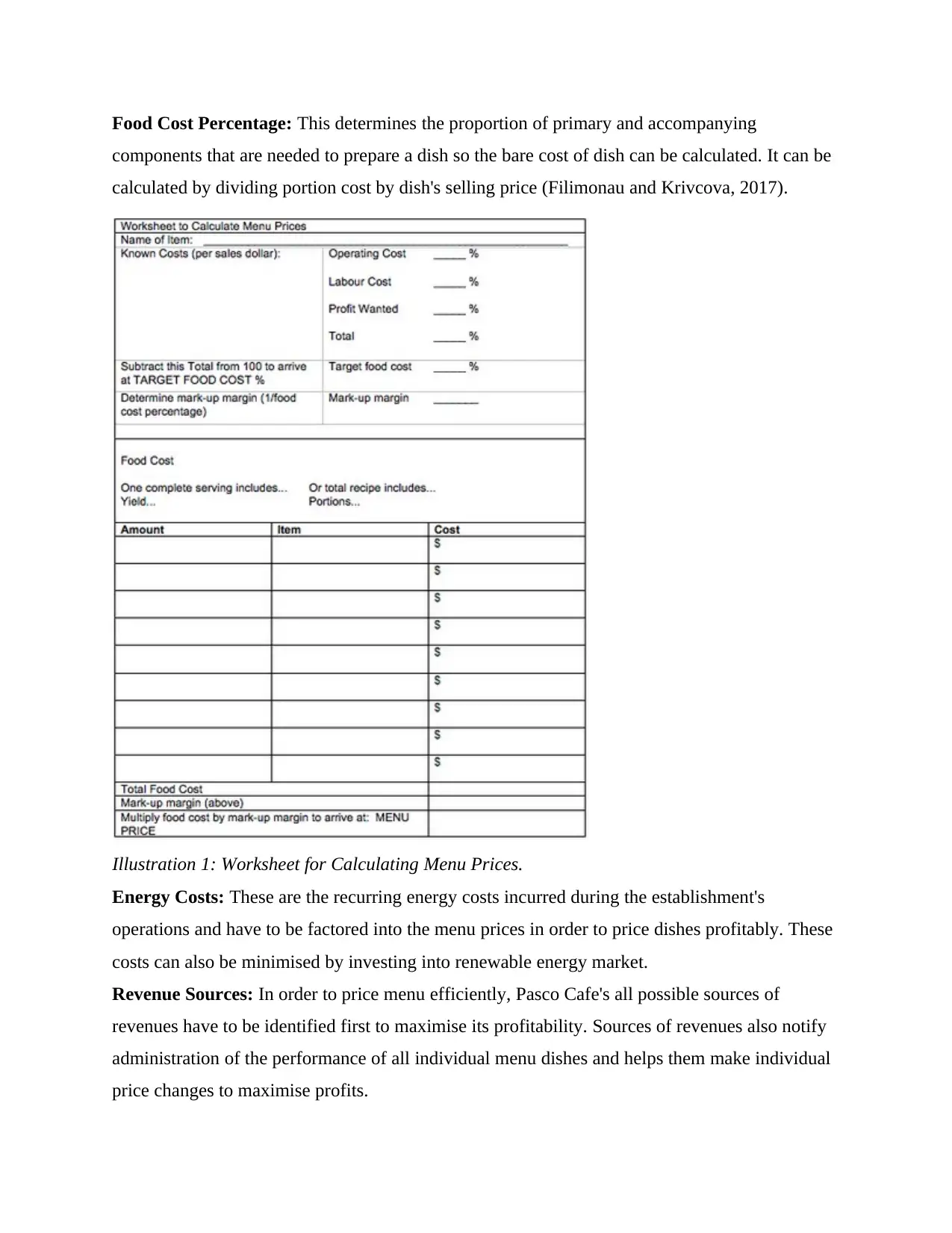
Food Cost Percentage: This determines the proportion of primary and accompanying
components that are needed to prepare a dish so the bare cost of dish can be calculated. It can be
calculated by dividing portion cost by dish's selling price (Filimonau and Krivcova, 2017).
Illustration 1: Worksheet for Calculating Menu Prices.
Energy Costs: These are the recurring energy costs incurred during the establishment's
operations and have to be factored into the menu prices in order to price dishes profitably. These
costs can also be minimised by investing into renewable energy market.
Revenue Sources: In order to price menu efficiently, Pasco Cafe's all possible sources of
revenues have to be identified first to maximise its profitability. Sources of revenues also notify
administration of the performance of all individual menu dishes and helps them make individual
price changes to maximise profits.
components that are needed to prepare a dish so the bare cost of dish can be calculated. It can be
calculated by dividing portion cost by dish's selling price (Filimonau and Krivcova, 2017).
Illustration 1: Worksheet for Calculating Menu Prices.
Energy Costs: These are the recurring energy costs incurred during the establishment's
operations and have to be factored into the menu prices in order to price dishes profitably. These
costs can also be minimised by investing into renewable energy market.
Revenue Sources: In order to price menu efficiently, Pasco Cafe's all possible sources of
revenues have to be identified first to maximise its profitability. Sources of revenues also notify
administration of the performance of all individual menu dishes and helps them make individual
price changes to maximise profits.
⊘ This is a preview!⊘
Do you want full access?
Subscribe today to unlock all pages.

Trusted by 1+ million students worldwide

Staffing Costs: Costs associated with hiring and maintaining staff has to be accounted for in the
menu prices.
Staffing Costs = Total sales / Number of employees.
Produce costs: The fluctuating costs of input seasonal ingredients plays major influence on
profitability of Pasco Cafe' and its menu prices (Lo, King and Mackenzie, 2017). These can be
calculated by including appropriate markup costs in present production costs.
LO3
P5 Realistic plan to develop menu that meets customer's and business requirements.
In order for Pasco Cafe' to develop a menu that satisfies its customers and business
requirements, it needs planned strategies for the following:
Target Customers: Pasco Cafe' needs to identify key target customers in market that it intends
to service and study their dietary preferences and habits to reflect back in their menu.
Menu Type: Based on the type of service Pasco wishes to provide to its customers, the cafe
needs to decide a menu type from static, cyclic or daily menus factoring in their desired
profitability.
Illustration 2: Sources of Revenues
menu prices.
Staffing Costs = Total sales / Number of employees.
Produce costs: The fluctuating costs of input seasonal ingredients plays major influence on
profitability of Pasco Cafe' and its menu prices (Lo, King and Mackenzie, 2017). These can be
calculated by including appropriate markup costs in present production costs.
LO3
P5 Realistic plan to develop menu that meets customer's and business requirements.
In order for Pasco Cafe' to develop a menu that satisfies its customers and business
requirements, it needs planned strategies for the following:
Target Customers: Pasco Cafe' needs to identify key target customers in market that it intends
to service and study their dietary preferences and habits to reflect back in their menu.
Menu Type: Based on the type of service Pasco wishes to provide to its customers, the cafe
needs to decide a menu type from static, cyclic or daily menus factoring in their desired
profitability.
Illustration 2: Sources of Revenues
Paraphrase This Document
Need a fresh take? Get an instant paraphrase of this document with our AI Paraphraser
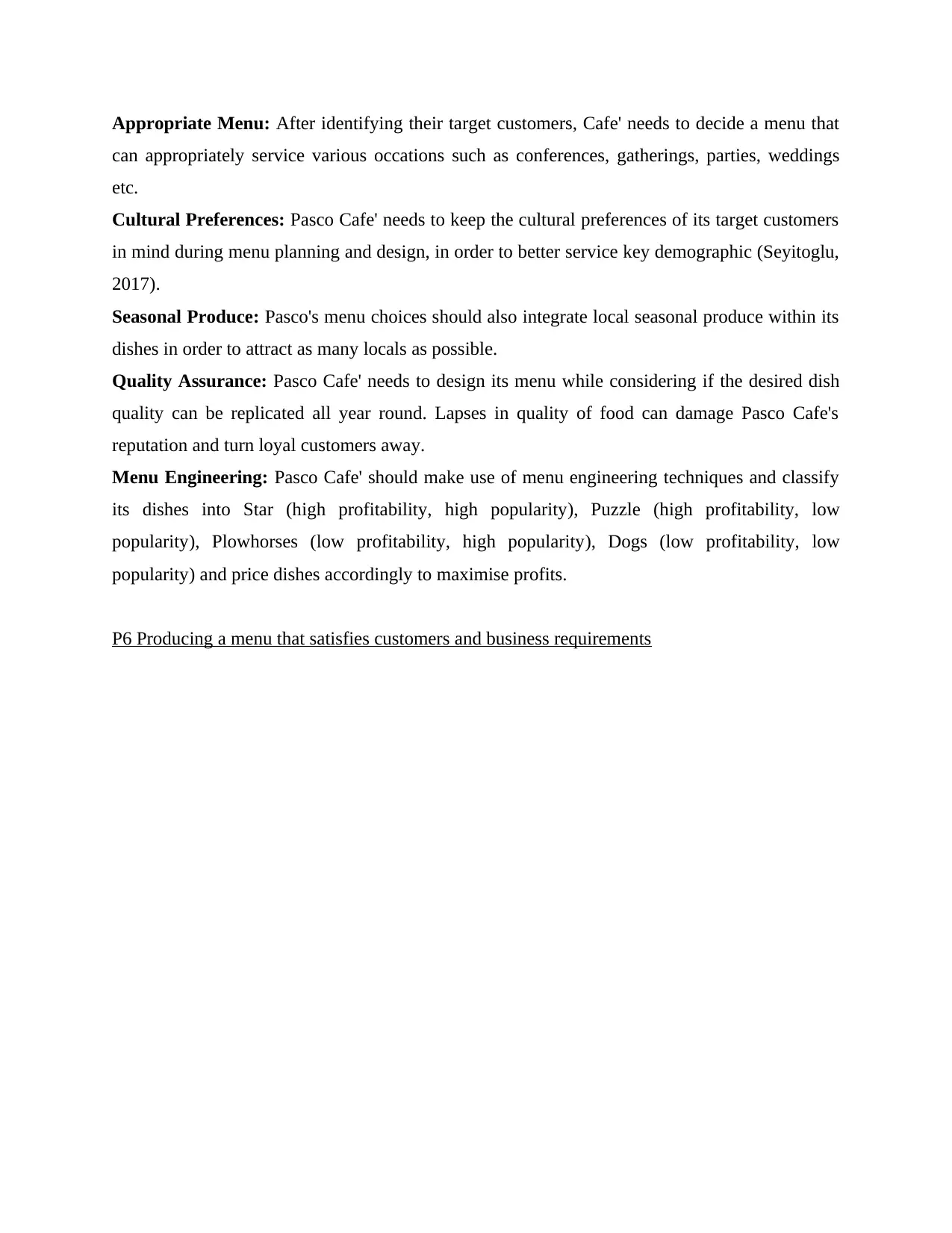
Appropriate Menu: After identifying their target customers, Cafe' needs to decide a menu that
can appropriately service various occations such as conferences, gatherings, parties, weddings
etc.
Cultural Preferences: Pasco Cafe' needs to keep the cultural preferences of its target customers
in mind during menu planning and design, in order to better service key demographic (Seyitoglu,
2017).
Seasonal Produce: Pasco's menu choices should also integrate local seasonal produce within its
dishes in order to attract as many locals as possible.
Quality Assurance: Pasco Cafe' needs to design its menu while considering if the desired dish
quality can be replicated all year round. Lapses in quality of food can damage Pasco Cafe's
reputation and turn loyal customers away.
Menu Engineering: Pasco Cafe' should make use of menu engineering techniques and classify
its dishes into Star (high profitability, high popularity), Puzzle (high profitability, low
popularity), Plowhorses (low profitability, high popularity), Dogs (low profitability, low
popularity) and price dishes accordingly to maximise profits.
P6 Producing a menu that satisfies customers and business requirements
can appropriately service various occations such as conferences, gatherings, parties, weddings
etc.
Cultural Preferences: Pasco Cafe' needs to keep the cultural preferences of its target customers
in mind during menu planning and design, in order to better service key demographic (Seyitoglu,
2017).
Seasonal Produce: Pasco's menu choices should also integrate local seasonal produce within its
dishes in order to attract as many locals as possible.
Quality Assurance: Pasco Cafe' needs to design its menu while considering if the desired dish
quality can be replicated all year round. Lapses in quality of food can damage Pasco Cafe's
reputation and turn loyal customers away.
Menu Engineering: Pasco Cafe' should make use of menu engineering techniques and classify
its dishes into Star (high profitability, high popularity), Puzzle (high profitability, low
popularity), Plowhorses (low profitability, high popularity), Dogs (low profitability, low
popularity) and price dishes accordingly to maximise profits.
P6 Producing a menu that satisfies customers and business requirements
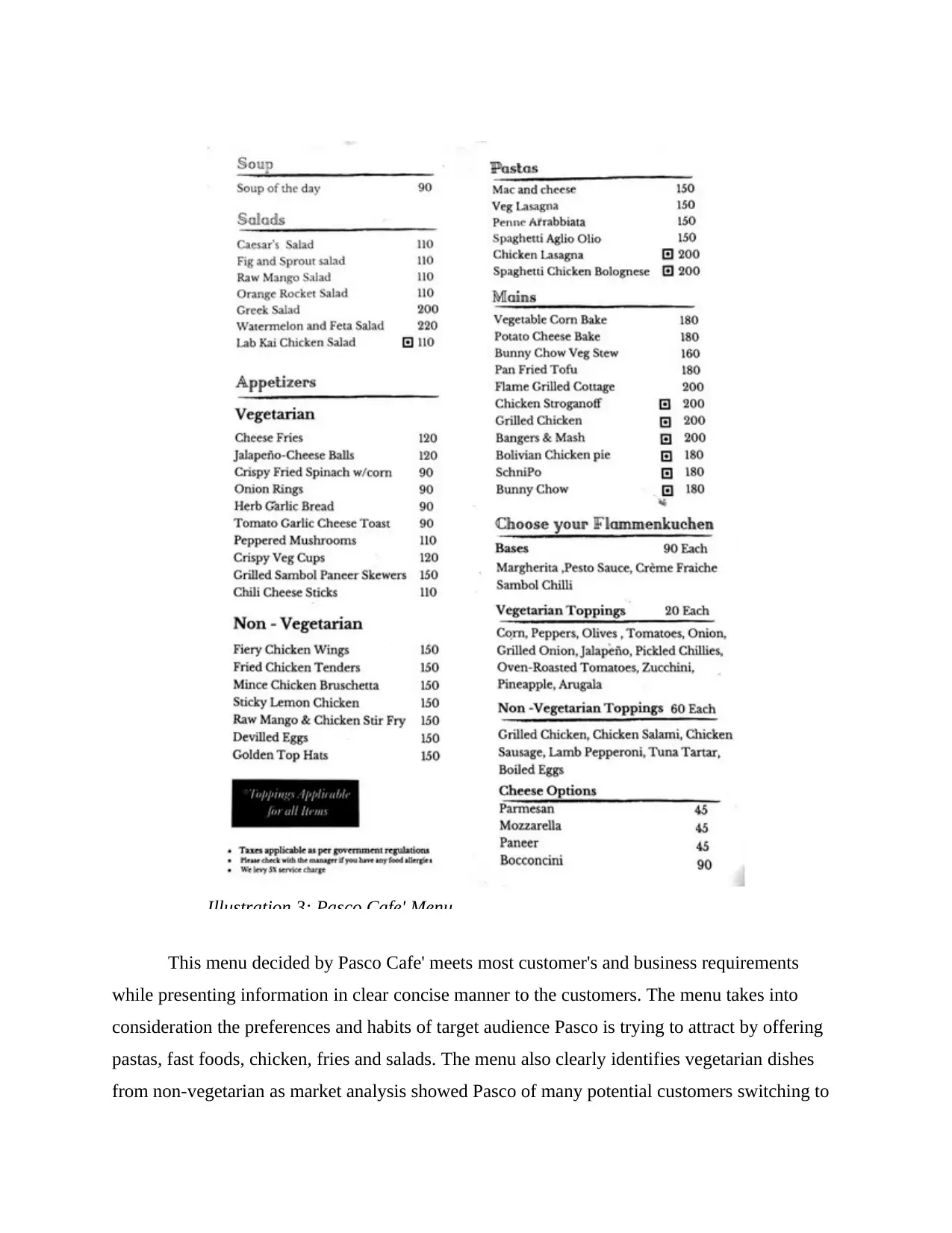
This menu decided by Pasco Cafe' meets most customer's and business requirements
while presenting information in clear concise manner to the customers. The menu takes into
consideration the preferences and habits of target audience Pasco is trying to attract by offering
pastas, fast foods, chicken, fries and salads. The menu also clearly identifies vegetarian dishes
from non-vegetarian as market analysis showed Pasco of many potential customers switching to
Illustration 3: Pasco Cafe' Menu
while presenting information in clear concise manner to the customers. The menu takes into
consideration the preferences and habits of target audience Pasco is trying to attract by offering
pastas, fast foods, chicken, fries and salads. The menu also clearly identifies vegetarian dishes
from non-vegetarian as market analysis showed Pasco of many potential customers switching to
Illustration 3: Pasco Cafe' Menu
⊘ This is a preview!⊘
Do you want full access?
Subscribe today to unlock all pages.

Trusted by 1+ million students worldwide
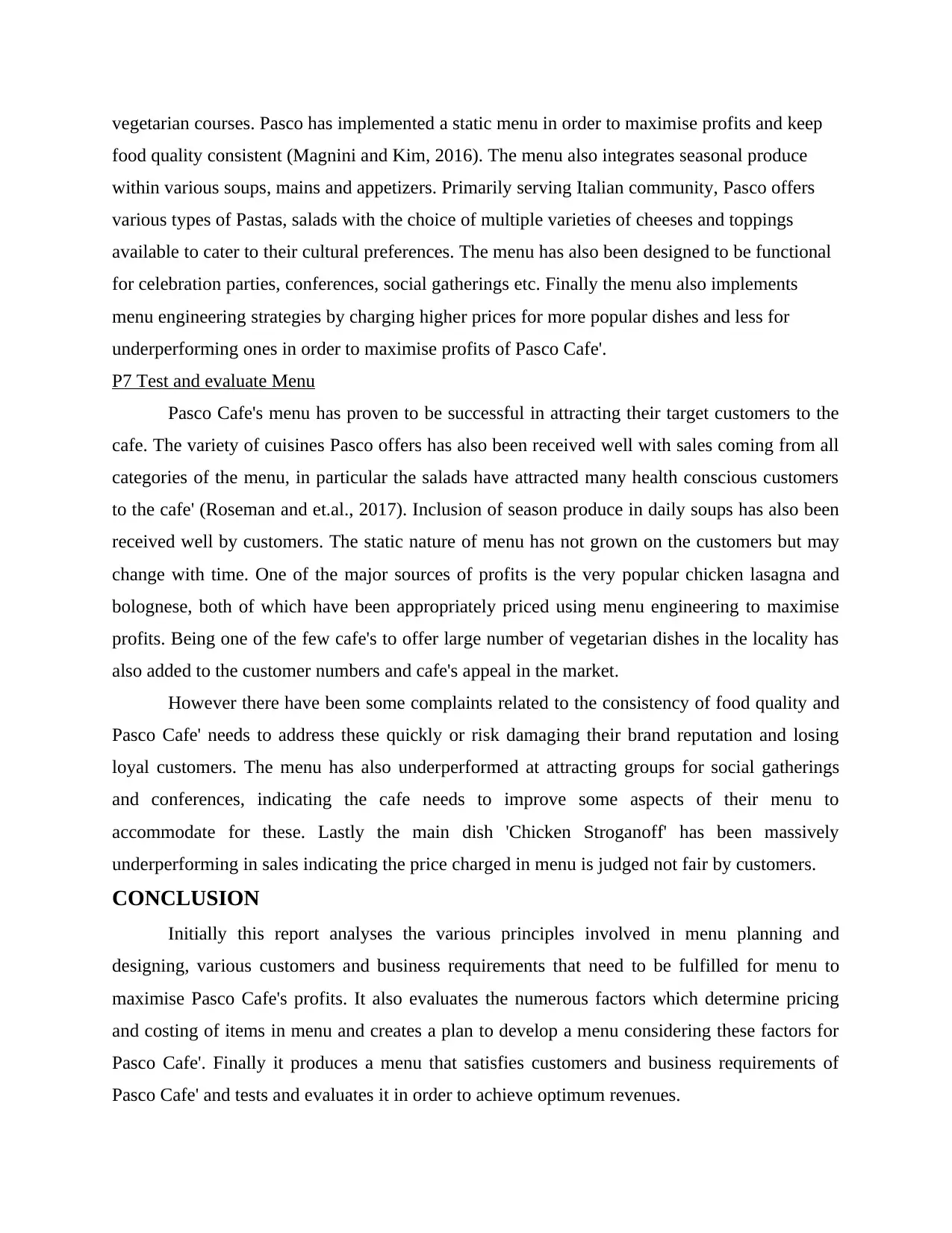
vegetarian courses. Pasco has implemented a static menu in order to maximise profits and keep
food quality consistent (Magnini and Kim, 2016). The menu also integrates seasonal produce
within various soups, mains and appetizers. Primarily serving Italian community, Pasco offers
various types of Pastas, salads with the choice of multiple varieties of cheeses and toppings
available to cater to their cultural preferences. The menu has also been designed to be functional
for celebration parties, conferences, social gatherings etc. Finally the menu also implements
menu engineering strategies by charging higher prices for more popular dishes and less for
underperforming ones in order to maximise profits of Pasco Cafe'.
P7 Test and evaluate Menu
Pasco Cafe's menu has proven to be successful in attracting their target customers to the
cafe. The variety of cuisines Pasco offers has also been received well with sales coming from all
categories of the menu, in particular the salads have attracted many health conscious customers
to the cafe' (Roseman and et.al., 2017). Inclusion of season produce in daily soups has also been
received well by customers. The static nature of menu has not grown on the customers but may
change with time. One of the major sources of profits is the very popular chicken lasagna and
bolognese, both of which have been appropriately priced using menu engineering to maximise
profits. Being one of the few cafe's to offer large number of vegetarian dishes in the locality has
also added to the customer numbers and cafe's appeal in the market.
However there have been some complaints related to the consistency of food quality and
Pasco Cafe' needs to address these quickly or risk damaging their brand reputation and losing
loyal customers. The menu has also underperformed at attracting groups for social gatherings
and conferences, indicating the cafe needs to improve some aspects of their menu to
accommodate for these. Lastly the main dish 'Chicken Stroganoff' has been massively
underperforming in sales indicating the price charged in menu is judged not fair by customers.
CONCLUSION
Initially this report analyses the various principles involved in menu planning and
designing, various customers and business requirements that need to be fulfilled for menu to
maximise Pasco Cafe's profits. It also evaluates the numerous factors which determine pricing
and costing of items in menu and creates a plan to develop a menu considering these factors for
Pasco Cafe'. Finally it produces a menu that satisfies customers and business requirements of
Pasco Cafe' and tests and evaluates it in order to achieve optimum revenues.
food quality consistent (Magnini and Kim, 2016). The menu also integrates seasonal produce
within various soups, mains and appetizers. Primarily serving Italian community, Pasco offers
various types of Pastas, salads with the choice of multiple varieties of cheeses and toppings
available to cater to their cultural preferences. The menu has also been designed to be functional
for celebration parties, conferences, social gatherings etc. Finally the menu also implements
menu engineering strategies by charging higher prices for more popular dishes and less for
underperforming ones in order to maximise profits of Pasco Cafe'.
P7 Test and evaluate Menu
Pasco Cafe's menu has proven to be successful in attracting their target customers to the
cafe. The variety of cuisines Pasco offers has also been received well with sales coming from all
categories of the menu, in particular the salads have attracted many health conscious customers
to the cafe' (Roseman and et.al., 2017). Inclusion of season produce in daily soups has also been
received well by customers. The static nature of menu has not grown on the customers but may
change with time. One of the major sources of profits is the very popular chicken lasagna and
bolognese, both of which have been appropriately priced using menu engineering to maximise
profits. Being one of the few cafe's to offer large number of vegetarian dishes in the locality has
also added to the customer numbers and cafe's appeal in the market.
However there have been some complaints related to the consistency of food quality and
Pasco Cafe' needs to address these quickly or risk damaging their brand reputation and losing
loyal customers. The menu has also underperformed at attracting groups for social gatherings
and conferences, indicating the cafe needs to improve some aspects of their menu to
accommodate for these. Lastly the main dish 'Chicken Stroganoff' has been massively
underperforming in sales indicating the price charged in menu is judged not fair by customers.
CONCLUSION
Initially this report analyses the various principles involved in menu planning and
designing, various customers and business requirements that need to be fulfilled for menu to
maximise Pasco Cafe's profits. It also evaluates the numerous factors which determine pricing
and costing of items in menu and creates a plan to develop a menu considering these factors for
Pasco Cafe'. Finally it produces a menu that satisfies customers and business requirements of
Pasco Cafe' and tests and evaluates it in order to achieve optimum revenues.
Paraphrase This Document
Need a fresh take? Get an instant paraphrase of this document with our AI Paraphraser
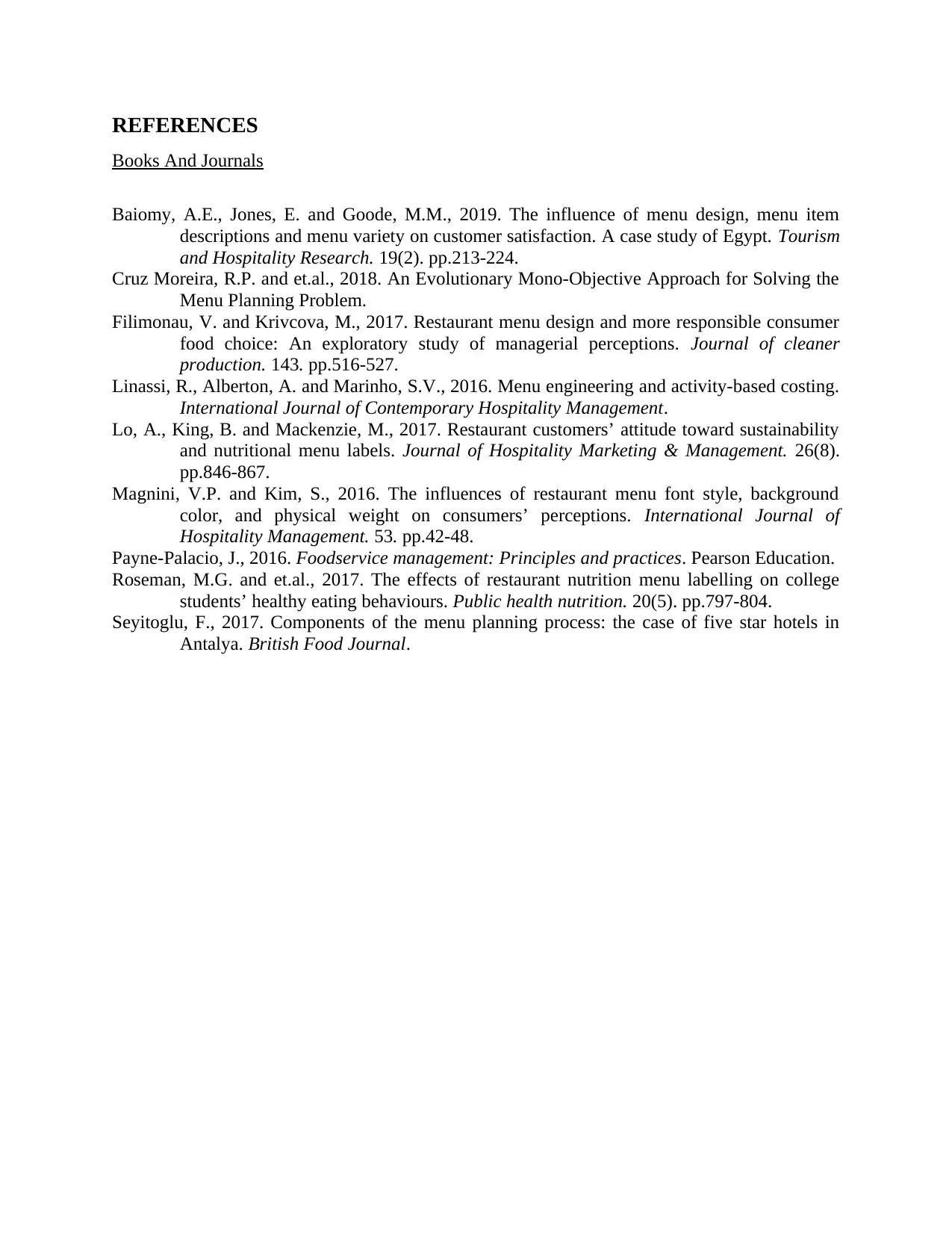
REFERENCES
Books And Journals
Baiomy, A.E., Jones, E. and Goode, M.M., 2019. The influence of menu design, menu item
descriptions and menu variety on customer satisfaction. A case study of Egypt. Tourism
and Hospitality Research. 19(2). pp.213-224.
Cruz Moreira, R.P. and et.al., 2018. An Evolutionary Mono-Objective Approach for Solving the
Menu Planning Problem.
Filimonau, V. and Krivcova, M., 2017. Restaurant menu design and more responsible consumer
food choice: An exploratory study of managerial perceptions. Journal of cleaner
production. 143. pp.516-527.
Linassi, R., Alberton, A. and Marinho, S.V., 2016. Menu engineering and activity-based costing.
International Journal of Contemporary Hospitality Management.
Lo, A., King, B. and Mackenzie, M., 2017. Restaurant customers’ attitude toward sustainability
and nutritional menu labels. Journal of Hospitality Marketing & Management. 26(8).
pp.846-867.
Magnini, V.P. and Kim, S., 2016. The influences of restaurant menu font style, background
color, and physical weight on consumers’ perceptions. International Journal of
Hospitality Management. 53. pp.42-48.
Payne-Palacio, J., 2016. Foodservice management: Principles and practices. Pearson Education.
Roseman, M.G. and et.al., 2017. The effects of restaurant nutrition menu labelling on college
students’ healthy eating behaviours. Public health nutrition. 20(5). pp.797-804.
Seyitoglu, F., 2017. Components of the menu planning process: the case of five star hotels in
Antalya. British Food Journal.
Books And Journals
Baiomy, A.E., Jones, E. and Goode, M.M., 2019. The influence of menu design, menu item
descriptions and menu variety on customer satisfaction. A case study of Egypt. Tourism
and Hospitality Research. 19(2). pp.213-224.
Cruz Moreira, R.P. and et.al., 2018. An Evolutionary Mono-Objective Approach for Solving the
Menu Planning Problem.
Filimonau, V. and Krivcova, M., 2017. Restaurant menu design and more responsible consumer
food choice: An exploratory study of managerial perceptions. Journal of cleaner
production. 143. pp.516-527.
Linassi, R., Alberton, A. and Marinho, S.V., 2016. Menu engineering and activity-based costing.
International Journal of Contemporary Hospitality Management.
Lo, A., King, B. and Mackenzie, M., 2017. Restaurant customers’ attitude toward sustainability
and nutritional menu labels. Journal of Hospitality Marketing & Management. 26(8).
pp.846-867.
Magnini, V.P. and Kim, S., 2016. The influences of restaurant menu font style, background
color, and physical weight on consumers’ perceptions. International Journal of
Hospitality Management. 53. pp.42-48.
Payne-Palacio, J., 2016. Foodservice management: Principles and practices. Pearson Education.
Roseman, M.G. and et.al., 2017. The effects of restaurant nutrition menu labelling on college
students’ healthy eating behaviours. Public health nutrition. 20(5). pp.797-804.
Seyitoglu, F., 2017. Components of the menu planning process: the case of five star hotels in
Antalya. British Food Journal.

⊘ This is a preview!⊘
Do you want full access?
Subscribe today to unlock all pages.

Trusted by 1+ million students worldwide
1 out of 12
Related Documents
Your All-in-One AI-Powered Toolkit for Academic Success.
+13062052269
info@desklib.com
Available 24*7 on WhatsApp / Email
![[object Object]](/_next/static/media/star-bottom.7253800d.svg)
Unlock your academic potential
Copyright © 2020–2025 A2Z Services. All Rights Reserved. Developed and managed by ZUCOL.





